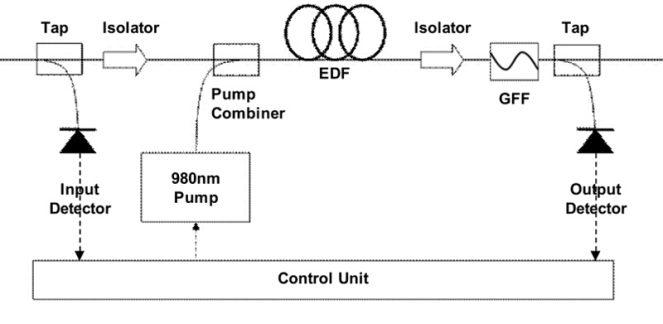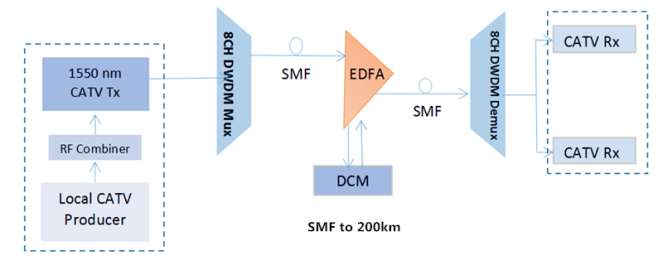DWDM (division multiplexing) technology is an ideal solution to address the capacity-hungry issue, which can simply fall into two types, passive DWDM and active DWDM. To greatly expand the bandwidth of the existing fiber system, both passive DWDM and active DWDM systems are designed to multiplex different wavelengths for carrying multiple signals over one single fiber. To better know the features of these two DWDM systems, the following will intend to learn what are the passive DWDM and active DWDM systems, and find their advantages and disadvantages.
Passive DWDM System Overview
Since there is no any active component used in the passive DWDM system, the performance of the passive DWDM link only depends on the optical budget of the DWDM transceivers used in the system. That’s to say, the transmission distance the passive DWDM system supports can’t be extended and is limited to the optical budget of the DWDM transceivers. We can learn from the figure below that shows a common passive DWDM system. Obviously, no active component like fiber amplifier and DCM module, but a pairs of 20 channels DWDM Mux are used. This design allows for high capacity transmission and makes capacity expansion possible. In short, it is very suitable to deploy passive DWDM system in metro networks and high speed and capacity communication lines.
Active DWDM System Overview
Unlike passive DWDM system, active DWDM system can be composed of fiber amplifier, DWDM Mux, DWDM transceiver, DCM module and OEO transponder, which can be also called transponder-based system. Due to its active feature, it is easier to manage and control the optical active DWDM network. Here offers the design of the active DWDM system for your reference.
In the active DWDM system, the transponder usually utilizes short wave 850nm or long wave 1310nm to do the optical-electrical-optical (OEO) DWDM conversion. When the long distance is required in the active DWDM system, several EDFA fiber amplifiers will be inserted along the active DWDM link. What should be noted is that the active DWDM link can’t be extended infinitely, because the number of fiber amplifiers for an active DWDM link is limited to the optical cable type, the channel count, the data transmission rate of each channel, and permissible OSNR value, etc.
Furthermore, the chromatic dispersion occurring in the optical transmission also makes an influence on the transmission distance of the active DWDM link. Hence, when designing the active DWDM system, we should also take the permissible chromatic dispersion values of the link into consideration. If needed, we can insert the dispersion compensators (dcm modules) into the active DWDM link to enhance the optical signals for a longer transmission.
Passive DWDM vs Active DWDM System
It is well known that the passive DWDM system doesn’t need fiber amplifiers or dispersion compensators, which may saves you a lot of time and money. Meanwhile, it is also very easy to deploy due to the uncomplex installation. However, there are also several disadvantages of passive DWDM system. Firstly, the scalability is not so good as the active one. With the development of the passive DWDM system, more passive devices are required. Meanwhile, the passive DWDM system will be difficult to manage with the increasing of passive devices. What’s worse, if a wavelength or connection needs to be changed in the link, the only option is to take it out of link and disconnect the connection.
As for the active DWDM system, it can multiplex more wavelengths over a single fiber pair. Hence, more bandwidth can be provided by the active DWDM system. Furthermore, the active setups make the optical system management easier. And you can directly change the wavelengths or connections in the link without dropping connections. Finally, the active DWDM system is more scalable than the passive one, which makes more wavelengths to be multiplexed over the fiber. But one the other hand, there are also two main disadvantages of active DWDM system. One is the high cost of the active DWDM devices, and the other one is the complex installation.
In conclusion, the active DWDM system can offer greater capacity and higher scalablity, while the the passive DWDM system needs less cost and is easy to deploy. If the passive DWDM system meets your need, you’d better not to choose the active one as it will cost you very high. All in all, there is no the best, but the most suitable for your system. Just choosing the most suitable DWDM for your system according to what your network needs.
















